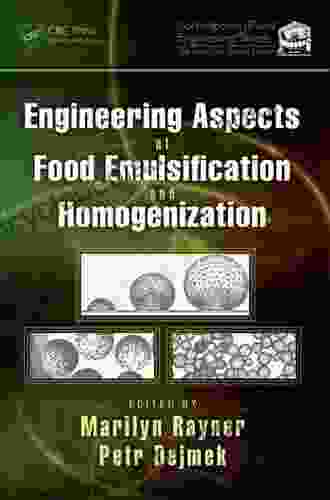Engineering Aspects Of Food Emulsification And Homogenization: Contemporary Food

Food emulsification and homogenization are two critical engineering processes that play a pivotal role in the development and production of various food products. These processes involve the manipulation of food systems to achieve desired physicochemical properties, sensory attributes, and nutritional functionality. This article aims to provide a comprehensive overview of the engineering aspects of food emulsification and homogenization, exploring their principles, applications, and challenges. 5 out of 5 Emulsification is the process of dispersing one immiscible liquid (the dispersed phase) into another (the continuous phase) to form a stable mixture called an emulsion. In food systems, emulsions are encountered in various products, such as salad dressings, mayonnaise, milk, and ice cream. For instance, salad dressings are typically oil-in-water emulsions where oil droplets are dispersed in a water-based solution. The stability of emulsions is crucial to prevent phase separation and maintain the desired texture and appearance of food products. Emulsion stability is influenced by various factors, including droplet size, interfacial tension, and the interactions between the dispersed phase, continuous phase, and emulsifiers. Emulsifiers are surface-active agents that play a critical role in stabilizing emulsions by reducing interfacial tension and preventing droplet coalescence. Different types of emulsifiers are used in food systems, including proteins, polysaccharides, and synthetic surfactants. The selection of an appropriate emulsifier depends on the specific food application and the desired emulsification properties. The engineering aspects of food emulsification involve the design and optimization of emulsification equipment and processes to achieve desired emulsion characteristics. Emulsification can be achieved through various mechanical methods, including: The selection of the appropriate emulsification method depends on factors such as the desired droplet size, emulsion stability, and the viscosity and composition of the food system. Homogenization is a process that reduces the size of fat globules or other dispersed particles in a food system to improve stability, texture, and appearance. Homogenization is commonly used in the production of dairy products, such as milk, cream, and cheese, to prevent the separation of cream from the milk serum. The principle of homogenization involves forcing the food system through a narrow valve or orifice under high pressure, which disrupts the fat globules and reduces their size. Smaller fat globules result in increased stability and a smoother texture. The engineering aspects of food homogenization focus on the design and optimization of homogenization equipment and processes to achieve the desired homogenization efficiency and product quality. The key engineering parameters in homogenization include: The optimization of homogenization parameters is essential to achieve the desired product quality while minimizing energy consumption and equipment wear. Food emulsification and homogenization are essential processes in the development and production of various contemporary food products. Some notable applications include: Despite the significant advancements in food emulsification and homogenization, several challenges and opportunities exist for future research and development. These include: Food emulsification and homogenization are essential engineering processes that play a vital role in the development and production of various contemporary food products. By manipulating food systems to achieve desired physicochemical properties, sensory attributes, and nutritional functionality, these processes enable the creation of innovative and high-quality foods. Continued research and development in this field will further enhance our understanding and utilization of these technologies, leading to advancements in food science and the delivery of healthier and more sustainable food products. Language : English File size : 23882 KB Print length : 331 pages Food Emulsification
Principles and Terminology
Engineering Aspects
Food Homogenization
Principles and Terminology
Engineering Aspects
Applications in Contemporary Food
Challenges and Future Directions
5 out of 5
| Language | : | English |
| File size | : | 23882 KB |
| Print length | : | 331 pages |
Do you want to contribute by writing guest posts on this blog?
Please contact us and send us a resume of previous articles that you have written.
 Book
Book Novel
Novel Page
Page Chapter
Chapter Text
Text Story
Story Genre
Genre Reader
Reader Library
Library Paperback
Paperback E-book
E-book Magazine
Magazine Newspaper
Newspaper Paragraph
Paragraph Sentence
Sentence Bookmark
Bookmark Shelf
Shelf Glossary
Glossary Bibliography
Bibliography Foreword
Foreword Preface
Preface Synopsis
Synopsis Annotation
Annotation Footnote
Footnote Manuscript
Manuscript Scroll
Scroll Codex
Codex Tome
Tome Bestseller
Bestseller Classics
Classics Library card
Library card Narrative
Narrative Biography
Biography Autobiography
Autobiography Memoir
Memoir Reference
Reference Encyclopedia
Encyclopedia Alex Johnson
Alex Johnson Alex Halberstadt
Alex Halberstadt Adam Bertocci
Adam Bertocci Alana Gardini
Alana Gardini Alan Zelenetz
Alan Zelenetz Alex Bellos
Alex Bellos Alec Potrero
Alec Potrero Adam Galinsky
Adam Galinsky Alex Genadinik
Alex Genadinik A J Stewart
A J Stewart Alan Sanders
Alan Sanders Alberto Savoia
Alberto Savoia Aaron Becker
Aaron Becker Alex Finlay
Alex Finlay Alan Christianson
Alan Christianson Ahmad Sahar
Ahmad Sahar Adam Mckeown
Adam Mckeown Ace Collins
Ace Collins Alan Kenworthy
Alan Kenworthy Alan Garner
Alan Garner
Light bulbAdvertise smarter! Our strategic ad space ensures maximum exposure. Reserve your spot today!

 Felix CarterUnlock the Power of Regression Analysis in Microsoft Excel: A Comprehensive...
Felix CarterUnlock the Power of Regression Analysis in Microsoft Excel: A Comprehensive... Alan TurnerFollow ·19.8k
Alan TurnerFollow ·19.8k Preston SimmonsFollow ·6.8k
Preston SimmonsFollow ·6.8k William WordsworthFollow ·4.6k
William WordsworthFollow ·4.6k Leslie CarterFollow ·15.9k
Leslie CarterFollow ·15.9k Deion SimmonsFollow ·14.6k
Deion SimmonsFollow ·14.6k Brett SimmonsFollow ·10.3k
Brett SimmonsFollow ·10.3k Jamison CoxFollow ·8.9k
Jamison CoxFollow ·8.9k Emmett MitchellFollow ·11.6k
Emmett MitchellFollow ·11.6k

 Francis Turner
Francis TurnerArt and Politics in the Shadow of Music
Music has...

 Jaylen Mitchell
Jaylen MitchellHow Algorithms Are Rewriting The Rules Of Work
The workplace is...

 Chandler Ward
Chandler WardRio de Janeiro & Minas Gerais Footprint Handbooks:...
Embark on an extraordinary adventure through...

 David Mitchell
David MitchellThe Story of Depression: Understanding and Treating a...
Delving into the Shadows of...

 Al Foster
Al FosterStatistics Done Wrong: The Woefully Complete Guide
Tired of being...

 DeShawn Powell
DeShawn PowellJulia Child's Second Act: A Tale of Triumph,...
Julia Child is an...
5 out of 5
| Language | : | English |
| File size | : | 23882 KB |
| Print length | : | 331 pages |










